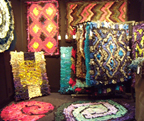A month ago, I brought home a truckload of t shirt scrap from TS Designs in Burlington. It’s sorted by color, and I’ve started sorting each color into different size and shape pieces. Both blue and oatmeal scrap had a large number of pieces of roughly the same size and shape. Because I am between rugs on the loom, I wanted to test these pieces to see how they might weave. I like to sample the “next next” rug so I can be preparing the fiber if I like the way the sample looks. I need to sample two rugs ahead because I may need to use the sample yardage to complete the rug. Hate to be 10 yards short when there are 10 yards tied up in a sample that’s still wrapped around the cloth beam.

Each piece is about five or six inches wide, almost 18 inches long, and cut on the diagonal at one end. Because this fabric is knit with stockinette stitch, it curls to the purl (rough) side. I am not trying to control the curve during this experiment.
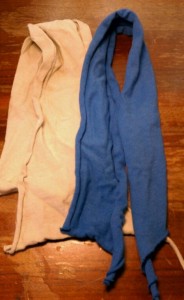
I lined up the diagonal ends so that the grain was aligned and double-stitched about 8 yards (total) of scrap pieces together. That’s a mid-century dying Singer; it only goes forward, not reverse, and won’t zig zag anymore. It’s beyond economical repair but as long as it can stitch, I can keep it oiled.
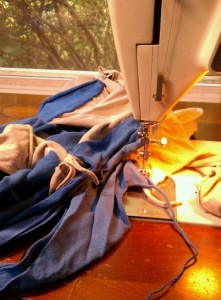
The sewn-up strip is too wide to weave on my loom’s current warp, so I cut it in half with a Martelli razor wheel. If I weave a whole rug out of these pieces using this assembly method, I’ll need to find a more efficient way to cut. I’ll need about 500 yards of finished fiber. Today, I only needed 8 yards total (16 after cutting) so cutting one layer manually was good enough. (I have electrical cutters. The problem arose managing the curl of the fabric, which interferes with folding and cutting more than one layer at a time.
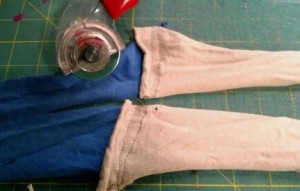
Storing weft fiber without getting it tangled is a bit of a challenge. This fiber will go straight to the loom, so I could wind it onto a shuttle instead of winding it into a hank.
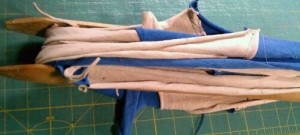
I’ll post more pictures when I get the sample woven, unless I hate the way it looks. In that case, I’ll unpick the weaving and rethink how I’m joining these pieces.

Boring! Sometimes, assembling bands of clearly-defined color leads to interesting swirl in a rug, but I don’t see anything appearing in this swatch. It could be that weaving a bigger sample would show more. However, in the time between winding the sample onto the shuttle and sitting down to weave, I thought of a whole ‘nother way to use these colors which tests well on my weaving software. Chalk this test up to “ways that won’t work” and move on.
